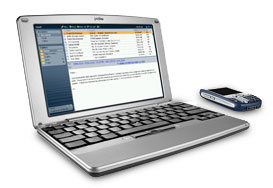![]() It’s silly, I know, but I’ve started to create custom icons for the various external drives I plug into my MacBook Pro.
It’s silly, I know, but I’ve started to create custom icons for the various external drives I plug into my MacBook Pro.
This is something I do rather regularly since the internal 100G drive only has about 3G spare, and I have to tidy things up frequently to keep even that much free! Most of my photos now live on a portable external drive which goes almost everywhere the laptop goes, and when I’m at home I plug in a couple of other drives as well.
Having pictorial representations of the disks in Finder windows and on the desktop makes it easier to know which ones are plugged in and turned on, and I’m much more likely to eject the right disk before unplugging it if they don’t all have the same generic icon. It’s a bit of effort to create the icons, but worth it, I think.
 Ah – now, this is really quite interesting. I’ve been watching and playing with a variety of smartphones and similar devices recently. They’re starting to get large amounts of storage, quite reasonable email apps and web browsers, and, with the advent of reasonably widespread 3G and Wifi, decent connectivity. In short, they have most of what I need, most of the time – especially while travelling. The one thing they lack is a decent-sized screen and keyboard, and for some time I’ve been thinking that something like an
Ah – now, this is really quite interesting. I’ve been watching and playing with a variety of smartphones and similar devices recently. They’re starting to get large amounts of storage, quite reasonable email apps and web browsers, and, with the advent of reasonably widespread 3G and Wifi, decent connectivity. In short, they have most of what I need, most of the time – especially while travelling. The one thing they lack is a decent-sized screen and keyboard, and for some time I’ve been thinking that something like an
Recent Comments